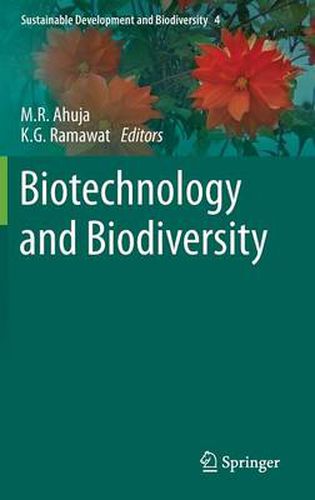Readings Newsletter
Become a Readings Member to make your shopping experience even easier.
Sign in or sign up for free!
You’re not far away from qualifying for FREE standard shipping within Australia
You’ve qualified for FREE standard shipping within Australia
The cart is loading…






This title is printed to order. This book may have been self-published. If so, we cannot guarantee the quality of the content. In the main most books will have gone through the editing process however some may not. We therefore suggest that you be aware of this before ordering this book. If in doubt check either the author or publisher’s details as we are unable to accept any returns unless they are faulty. Please contact us if you have any questions.
The purpose of this book is to assess the potential effects of biotechnological approaches particularly genetic modification on biodiversity and the environment. All aspects of biodiversity such as ecological diversity, species diversity and genetic diversity are considered. Higher organisms contain a specific set of linear DNA molecules called chromosomes and a complete set of chromosomes in an organism comprises its genome. The collection of traits displayed by any organism (phenotype) depends on the genes present in its genome (genotype). The appearance of any specific trait also will depend on many other factors, including whether the gene(s) responsible for the trait is/are turned on (expressed) or off, the specific cells within which the genes are expressed and how the genes, their expression and the gene products interact with environmental factors. The primary biotechnology which concerns us is that of genetic manipulation, which has a direct impact on biodiversity at the genetic level. By these manipulations, novel genes or gene fragments can be introduced into organisms (creating transgenics) or existing genes within an organism can be altered. Transgenics are a major area of concern, combining genes from different species to effectively create novel organisms. Current rates of disappearance of biological and cultural diversity in the world are unprecedented. Intensive resource exploitation due to social and economic factors has led to the destruction, conversion or degradation of ecosystems. Reversing these trends requires time to time assessment to integrate conservation and development.
$9.00 standard shipping within Australia
FREE standard shipping within Australia for orders over $100.00
Express & International shipping calculated at checkout
This title is printed to order. This book may have been self-published. If so, we cannot guarantee the quality of the content. In the main most books will have gone through the editing process however some may not. We therefore suggest that you be aware of this before ordering this book. If in doubt check either the author or publisher’s details as we are unable to accept any returns unless they are faulty. Please contact us if you have any questions.
The purpose of this book is to assess the potential effects of biotechnological approaches particularly genetic modification on biodiversity and the environment. All aspects of biodiversity such as ecological diversity, species diversity and genetic diversity are considered. Higher organisms contain a specific set of linear DNA molecules called chromosomes and a complete set of chromosomes in an organism comprises its genome. The collection of traits displayed by any organism (phenotype) depends on the genes present in its genome (genotype). The appearance of any specific trait also will depend on many other factors, including whether the gene(s) responsible for the trait is/are turned on (expressed) or off, the specific cells within which the genes are expressed and how the genes, their expression and the gene products interact with environmental factors. The primary biotechnology which concerns us is that of genetic manipulation, which has a direct impact on biodiversity at the genetic level. By these manipulations, novel genes or gene fragments can be introduced into organisms (creating transgenics) or existing genes within an organism can be altered. Transgenics are a major area of concern, combining genes from different species to effectively create novel organisms. Current rates of disappearance of biological and cultural diversity in the world are unprecedented. Intensive resource exploitation due to social and economic factors has led to the destruction, conversion or degradation of ecosystems. Reversing these trends requires time to time assessment to integrate conservation and development.